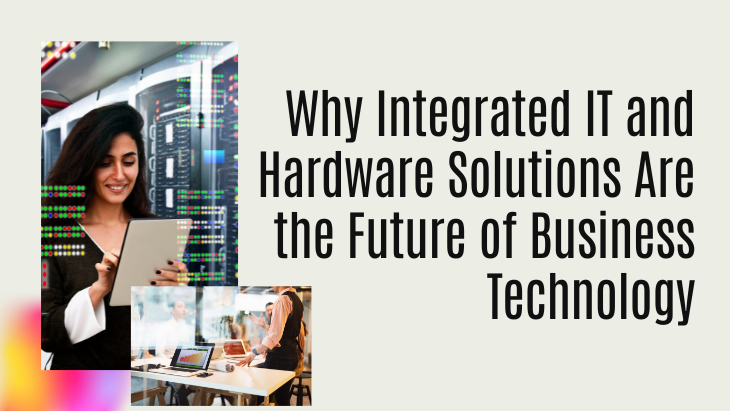As the digital world moves at a breakneck speed, companies are under mounting pressure to operate efficiently, securely, and adaptively. Older IT infrastructure based on isolated hardware, disparate software, and even manual interventions are no longer capable of keeping up with current requirements. Here's where Integrated IT & Hardware Solutions enters the scene. By unifying infrastructure, software, and devices in a single system, companies can experience hassle-free operations, quicker troubleshooting, increased productivity, and a future-proofed workplace. Integrated IT & Hardware Solutions The convergence of hardware and IT is not merely a trend it's becoming a strategic imperative for organizations to remain competitive in a digitally connected world.
Why Integration Matters in a Digitally Connected World
Today's workplace is no longer limited to one place or time zone. Staff work from anywhere, work in real time, and need to access information and tools from more than one device. Under such conditions, disparate IT systems can be a hindrance to productivity. Integrated IT & Hardware Solutions guarantees that all devices from servers and network equipment to endpoint systems speak with each other. This breaks down silos, improves data flow, and enables IT staff to manage systems centrally. Integration also provides for a single security policy, minimizing vulnerabilities and simplifying compliance across all hardware and software platforms.
Increasing Productivity With Seamless System Performance
Integrated IT & Hardware Solutions has the potential to drastically improve the productivity of employees by minimizing downtime and making systems easier to use. When IT and hardware are integrated, companies can streamline their workflows, automate repetitive tasks, and have all departments operate on synchronized systems. Employees no longer have to grapple with incompatible hardware, software bugs, or laborious manual updates. It could be cloud-based collaboration software, real-time access to data, or device provisioning whatever it is, integrated systems do it faster and with greater reliability. The outcome is a more productive workforce and smarter use of company assets.
Cutting Operational Expenses with Clever Integration
Through system consolidation and embracing scalable platforms, companies can save capital expenses on redundant hardware and get rid of duplicative software licenses. IT maintenance and support become less expensive as well, since there are fewer systems to cause problems. Monitoring and predictive analytics tools—frequently built into integrated platforms can spot impending failures before they happen, and the firm can avoid expensive downtimes. These cost-saving benefits make integrated solutions a smart investment, particularly for small and medium enterprises looking to scale sustainably.
Improving Security and Compliance Standards
Cybersecurity is a top priority for modern businesses, and integrated IT systems offer better protection than standalone solutions. With unified security frameworks in place, organizations can enforce consistent access controls, monitor threats in real time, and automate updates across all devices and networks. Integrated systems make it easier to achieve industry compliance requirements through features of centralized logging, auditing, and reporting. Companies in the healthcare, finance, and e-commerce sectors can especially gain advantages from integrated IT & hardware solutions because they must comply with stringent regulatory demands alongside upholding the integrity of sensitive information.
Improving User Experience Throughout the Organization
An integrated IT environment enables a seamless user experience across everyone involved from the support team to the end users in departments. Streamlined login procedures, quicker access to data, standardized interfaces, and stable performance are just a few of the concrete advantages enjoyed by the users. If systems are linked and hardware is specialized for particular workflows, staff can perform their tasks easily without extensive training or assistance. Additionally, integration allows IT teams to deploy updates, patches, and new tools with little disruption, which simplifies life for technical and non-technical personnel alike.
Facilitating Scalability and Business Expansion
As businesses expand, so do their IT requirements. Integrated IT & Hardware Solutions provide the scalability needed to absorb that expansion seamlessly. Whether it is opening up new locations, hiring new teams, or introducing digital offerings, companies can scale their integrated systems at ease without having to begin from scratch. Cloud integration also reinforces scalability with the ability to add storage, users, or compute capabilities on a needs basis. This adaptability is especially important for startups and mid-sized organizations that look forward to big growth and require IT infrastructure that can scale up with them without disrupting business.
Data-Driven Insights and Smarter Decision-Making
Seamless systems enable single-source data collection and analysis through all touchpoints. When hardware and software collaborate, data from all devices, users, and systems can be combined and analyzed in real-time. Business decision-makers can make faster, smarter choices informed by actionable insights. Whether it's IT performance monitoring, monitoring employee productivity, or optimizing customer service, integrated platforms offer transparency into operations. These observations are critical to strategic planning and allow companies to react more rapidly to market needs.
Future-Proofing Your Business with IT Hardware Integration
Technology is always changing at a fast rate, and it takes a proactive strategy to stay ahead. Integrated IT & hardware solutions form the basis of embracing upcoming technologies such as AI, IoT, and machine learning. When integration is in place, companies are able to seamlessly add new tools and technologies to their processes without significant interruptions. This responsiveness makes companies more resilient to change and better suited to innovate. Basically, integration is a kind of future-proofing that helps your company stay relevant, effective, and competitive in a progressively technology-oriented marketplace.
Conclusion
In summary, Integrated IT & Hardware Solutions is defining business technology's future by offering a consolidated, secure, and efficient environment. Praise-Group During the process of digital transformation, while businesses are stumbling, those embracing integration will not just remain but flourish. By lowering costs, enhancing productivity, improving security, and aiding innovation, integrated systems pay dividends in every function of a business. For companies seeking to remain competitive in their markets, the option is unmistakable accepting integrated IT and hardware is not an option; it's a necessity.





Leave a reply